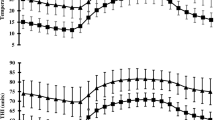Abstract
The aims of the present work were to analyse the variations of haematological variables in neonatal bovine submitted to different photoperiods and to establish the origin and the ontogeny of the rhythms. This work was carried out during the months of June and July of 2004. Twelve Holstein bovine were used, and they were divided into two groups and submitted to different photoperiods. One group received LD 10:14 and the other one LD 24:00. Blood samples by jugular punction were obtained from animals of 3, 7, 14, 20 and 30 days of life (LD 10:14) and the ones with 30 days of life (LD 24:00), during a period of 24 h at intervals of 2 h. The following tests of erythrocytes, haemoglobin concentration, lymphocytes, monocytes, granulocytes and platelets were done in all samples. Haematological variables were measured by means of a haematological counter and analysed by repeated measures through analysis of variance and cosinor analysis. There were chronobiological variations adjusted to daily rhythms in the erythrocytes, haemoglobin, lymphocytes, monocytes and granulocytes. The platelets variable presented ultradian variations. The biological rhythms of free running in calves under constant light conditions go on being expressed, showing the existence of an endogenous biological clock. With respect to the establishment of the biological rhythms in neonatal bovines, it is observed that the circadian system is not totally present at the moment of birth but is developed during the postnatal period. At birth, calves present ultradian rhythms in most of their variables but, progressively, they shorten their frequencies until settling down daily; this transition corresponds to the period of morphophysiological changes of the digestive system. The results shown in this study evidence that most of haematological variables represent circadian rhythms synchronised mainly by the photoperiod.






Similar content being viewed by others
Abbreviations
- Φ :
-
Acrophase
- A 0 :
-
MESOR
- A 1 :
-
amplitude
- t :
-
time
- T :
-
period
- W :
-
the angular frequency
References
Berger J (1983) Seasonal influences on circadian rhythms in the blood picture of SPF rats housed under artificial illumination. Folia Haematol (Frankf) 110:55–70
Brun-Hansen HC, Kampen AH, Lund A (2006) Hematologic values in calves during the first 6 months of life. Vet Clin Pathol 35(2):182–187. doi:10.1111/j.1939-165X.2006.tb00111.x
Buttner D (1992) Social influences on the circadian rhythm of locomotor activity and food intake of guinea pigs. J Interdiscip Cycle Res 23:100–112
Crowley M, Bovet J (1980) Social synchronization of circadian rhythms in deer mice (Peromyscus maniculatus). Behav Ecol Sociobiol 7:99–105. doi:10.1007/BF00299514
Davis FC, Gorski RA (1985) Development of hamster circadian rhythms: I. Within litter synchrony of mother and pup activity rhythms at weaning. Biol Reprod 33:353–362. doi:10.1095/biolreprod33.2.353
Doxey DL (1977) S.I. units: the new method of recording laboratory results of diagnostic purpose. Vet Rec 100:555–556
Durotoye LA, Fadairo MO, Avwemorue AK (2000) Diurnal variation in blood parameters in the chicken in the hot tropical climate. Afr J Biomed Res 3:143–147
Gatta D, Greppi GF, Casini L et al (1992) Feeding schedule and daily fluctuations of hematological parameters in horse. Gesellschaft für Ernahrungsphysiologie, Gottingen, p 86
Greppi GF, Casini L, Gatta D, Orlandi M, Pasquini M (1996) Daily fluctuations of haematology and blood biochemistry in horses fed varying levels of protein. Equine Vet J 28:350–353
Gruart A, Delgado MJ, Escobar C, Aguilar Robledo R (2002). Los relojes que gobiernan la vida. Ed. La ciencia /188 para todos. México, pp 197
Halberg F, Johnson EA, Nelson W, Runge W, Sothern R (1972) Autorythmometry procedures for physiologic self measurements and their analysis. Physiol Teach 1:1–11
Halberg F, Cornelissen G, Bingham C, Fujii S, Halberg E (1977) Glossary of chronobiology. Chronobiologia 4(suppl.1):1–189
Hardin P, Hall J, Rosbash R (1990) Feedbak of the drosophila period gene product on circadian cycling of its messager RNA. Nature 343:536–540. doi:10.1038/343536a0
Haus E (1992) Chronobiology of circulating blood cells and platelets. In: Touitou Y, Haus E (eds) Biologic rhythms in clinical and laboratory medicine. Springer, Berlin, pp 504–526
Haus E, Touitou Y (1992) Principles of clinical chronobiology. In: Touitou Y, Haus E (eds) Biologic rythms in clinical and laboratory medicine. Springer, Berlin, pp 6–27
Kavaliers M (1980) Social groupings and circadian activity of the killifish, Fundulus heterociclos. Biol Bull 158:69–76. doi:10.2307/1540759
Menaker M, Eskin A (1966) Entrainment of circadian rhythms by sound in Passer domesticus. Science 154:1579–1581. doi:10.1126/science.154.3756.1579
Moore-Ede MC (1986) Physiology of the circadian timing system: predictive versus reactive homeostasis. Am J Physiol 250:R737–R751
Mrosovsky N, Reebs SG, Honrado GI, Salmón PA (1989) Behavioral entrainment of circadian rhythms. Cell Mol Life Sci 45:696–702. doi:10.1007/BF01974561
Muri C, Schottstedt T, Hammon HM, Meyer E, Blum JW (2005) Hematological, metabolic and endocrine effects of feeding vitamin A and lactoferrin in neonatal calves. J Dairy Sci 88:1062–1077
Piccione G, Caola G, Refinetti R (2005) Daily rhythms of blood pressure, heart rate, and body temperature in fed and fasted male dogs. J Vet Med A 52:377–381. doi:10.1111/j.1439-0442.2005.00758.x
Reinberg A (1982) La cronofarmacología. Mundo científico 2:634–646
Rérat M, Zbinden Y, Saner R, Hammon H, Blum JW (2005) In vitro embryo production: growth performance, feed efficiency, and hematological, metabolic, and endocrine status in calves. J Dairy Sci 88:2579–2593
Sanni AA, Oyedokun OR, Alaka OO (2000) Preliminary observations on diurnal rhythm in the haematological parameters of male African giant rats (Cricetomys gambianus, Waterhouse). Afr J Biomed Res 3:117–120
Touitou Y, Touitou C, Bogdan A, Chasselut J, Beck H, Reinberg A (1979) Circadian rhythm in blood variables in elderly subjects. In: Reinberg A, Halberg F (eds) Chronopharmacology: advances in the biosciences. vol. 19. Pergamon, New York, pp 283–290
Young M (1992) Molecular genetics of biological rhythms. Marcel Decker, New York, p 336
Author information
Authors and Affiliations
Corresponding author
Rights and permissions
About this article
Cite this article
Cerutti, R.D., Scaglione, M.C. & Boggio, J.C. Establishment and endogeny of haematologic rhythms in calves. Comp Clin Pathol 18, 301–311 (2009). https://doi.org/10.1007/s00580-008-0804-5
Received:
Accepted:
Published:
Issue Date:
DOI: https://doi.org/10.1007/s00580-008-0804-5




